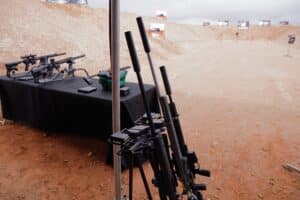Wayne LaPierre won.
Vocal dissent on the NRA board has been weeded out. Last weekend’s Annual Meeting saw Philip Journey and Frank Tait serve their final days as NRA board members. They were the last of the NRA officials who have publicly challenged the legitimacy of LaPierre and now they’re gone.
The years-long fight was decided almost as soon as it began. Former president Oliver North was run out of the last Annual Meeting in Indianapolis, Indiana after his fight with LaPierre broke out into public view. Top officials either accused of corruption or opposed to LaPierre’s continued leadership have been pushed out ever since.
Now that the task is over, I look at how it all unfolded and where things stand now.
Contributing Writer Jake Fogleman examines how his home state’s proposed “assault weapons” ban failed and what that might mean for the recent momentum such bans have enjoyed. Like permitless gun-carry, AR-15 bans seem to be hitting up against the political reality of further expansion. But the bans have a legal reality baring down on them too.
Plus, Frank Tait joins the podcast to talk about his time on the NRA board and whether he thinks internal reforms are still possible.

Analysis: The NRA’s Internal Fight is Over. Wayne LaPierre Won. [Member Exclusive]
By Stephen Gutowski
A crowd of NRA members rose to their feet and cheered Wayne LaPierre on Saturday as he finished delivering his speech in an Indianapolis conference hall.
It was the second standing ovation LaPierre received at the 2023 Annual Meeting last weekend. The long-time NRA Executive Vice President enjoyed a mostly-positive reception while presiding over a resurgent conference. And he vanquished the last of his vocal dissenters on the group’s board of directors.
The internal fight over alleged financial impropriety by LaPierre and others has raged since the last time the group headed to the Indiana Convention Center in 2019. Charges that he diverted the non-profit’s funds to pay for his private jet travel, luxury vacations, and bespoke suits, as well as using the superyacht of a top NRA contractor on a regular basis, have dogged him ever since. It has led to a complete reshuffle of top NRA positions, a series of legal challenges that threaten the group’s existence, and contributed to declining revenues primarily driven by a massive dropoff in membership.
The outcome of the internal fight will likely determine the organization’s future, which faces potentially ruinous legal sanctions and already appears headed toward another bankruptcy unless it can stop its membership drain.
A big part of that fight was decided almost immediately after the battle began back in 2019. As the meeting of members descended into chaos, one important figure was missing: then-president Oliver North. After accusing LaPierre of inappropriate use of NRA funds, and subsequently being accused of extortion by LaPierre, North left the Annual Meeting in defeat.
North was not reelected in the marathon board meeting that followed, while LaPierre was. Over the next several months, more top NRA officials were pushed out. Long-time treasurer Woody Phillips, LaPierre chief of staff Josh Powell, top lobbyist Chris Cox, and about half a dozen board members who spoke out against LaPierre were gone within the next year.
LaPierre admitted to taking several hundred thousand dollars in “excess benefits” on the NRA’s 2019 IRS filing. But it blamed most of the group’s issues on the purged officials and former top contractor Ackerman McQueen. The NRA’s outside lawyer, Bill Brewer, has argued the group weeded out the bad actors and initiated reforms–despite LaPierre being accused of diverting millions more NRA dollars to himself and remaining in charge.
The NRA has continued to bleed board members, including some of its most famous. It’s lost another treasurer and top lobbyist. But there was a vocal minority of dissidents on the board throughout that time.
When LaPierre decided to take the NRA into bankruptcy (without first informing the board) as a long-shot attempt to evade the New York corruption suit it faced, a handful of board members intervened in the case against the wishes of NRA leadership. Neither side got what they wanted when the case was tossed largely because the gun-rights group was, as they trumpeted in public, still solvent.
But Rocky Marshall, one of the leaders of the intervention attempt, was not renominated to appear on the ballot for the board last year–a process almost entirely controlled by the board’s nominating committee. He was later put up as the first person to run against LaPierre for the first time in decades but only garnered three votes. A more prominent opponent, Allen West, fared even worse the following year.
The vast majority of the 76-member board never bought into the campaign to remove LaPierre. And the membership didn’t seem to either, though two canceled Annual Meetings due to Covid concerns likely didn’t help the cause. It’s likely no coincidence internal activism has declined at the same time NRA membership has dropped, and the coffers of other gun-rights groups have expanded–even if there isn’t a one-to-one correlation.
However, dissident board members have been able to keep the fight going. Philip Journey and Frank Tait remained on the board despite also being leaders in the effort to oppose leadership in the bankruptcy–Tait before he even joined the board. Those two lonely voices fell silent as the NRA board met on Monday.
Their time on the board had also come to an end. And, just like that, the last NRA officials openly critical of LaPierre were gone.
The NRA will move forward with the legal and financial strategy LaPierre and Brewer have laid down over the last four years. There is no reason to expect things to change in the short term–not even the private jet flights.
Of course, the future of the NRA may be out of their control since one of the remaining possible punishments at play in the New York case is the ouster of LaPierre and other members of leadership. And the internal dissent isn’t necessarily gone either. Surprisingly, a short time after NRA members gave LaPierre a standing ovation, a resolution calling for his resignation saw support from about a third of those in attendance.
So, the fight for the NRA is over. Wayne LaPierre won. But it may not be a lasting victory.
Podcast: Former NRA Board Member Frank Tait on Reform Efforts [Member Early Access]
By Stephen Gutowski
The NRA’s 2023 Annual Meeting was last week. The group was resurgent, and leadership got a mostly warm welcome.
That doesn’t mean the NRA’s problems are solved. To the contrary, it still seems to be bleeding membership revenue at the same time it racks up increasing legal bills from dealing with multiple corruption suits over allegations of financial impropriety. That’s why we have Frank Tait, who just finished his term on the NRA board, on the show this week.
Tait, who joined the board as a vocal critic of Executive Vice President Wayne LaPierre, admitted attempts to reform the group from within have failed. He responded to several of the most common defenses of LaPierre, often employed by other members of the board, and explained why he believes the organization is in dire trouble.
He also talked about his time on the board. He said NRA staff made it very difficult for board members to access key documents. He also described how the 76-member board functions in practice, saying a small fraction of the board holds the majority of the decision-making power.
Tait also said he doesn’t plan to run for re-election in large part because he no longer sees a viable path to changing leadership from the inside.
Plus, Contributing Writer Jake Fogleman and I discuss what Colorado’s failure to pass an “assault weapons” ban means for the policy’s recent momentum.
The show is available to listen to on your favorite podcasting app or by clicking here. Video of the episode is up on our YouTube channel. Reload Members get access on Sunday. Everyone else can listen on Monday.
Come on the Podcast
One of the many perks of a Reload membership is the opportunity to appear on the podcast. We’ve had a lot of people on the show from all kinds of backgrounds. It’s one of my favorite segments since it gives us all a better insight into the community that makes this publication possible. If you want to come on the show, just reply to this email and let me know!

Analysis: Does Colorado Show the State ‘Assault Weapon’ Ban Resurgence Starting to Fizzle Out? [Member Exclusive]
By Jake Fogleman
Despite enjoying a recent resurgence in deep-blue states, “assault weapon” ban proponents are starting to confront the political and legal constraints to the policy’s continued expansion.
On Wednesday, the Colorado House of Representatives voted to kill a long-awaited proposal to ban the sale of dozens of semi-automatic rifles, pistols, and shotguns with certain targetted features, such as a pistol grip or telescoping stock, in its first committee hearing. Three Democrats joined the four Republicans on the committee in voting to reject the bill, as well as a proposed amendment to limit the ban to just bump stocks.
That an assault weapon ban failed to even make it out of committee in a legislative chamber where Democrats have a supermajority speaks to the tricky politics gun-control advocates still face for gun bans, even in states with trifecta Democratic control. The fact that bills to raise the minimum age to purchase firearms, impose a three-day waiting period, expand who can file a red flag petition, and impose civil liability on the gun industry all easily cleared the Colorado General Assembly this session highlights how much more difficult going after popular guns, such as the AR-15, really is.
A hardware ban is simply a different animal, politically speaking. That fact alone could do a lot to limit the ban’s potential to reach more than a handful of the most progressive-leaning states.
Assault weapon ban proponents have enjoyed several successes in recent years. The policy began to show its first signs of resurgence with Delaware’s adoption in the summer of 2022, followed by Illinois’ adoption of its own semi-auto rifle and magazine ban this January. The two laws marked the first new states to pass bans in over 20 years. And now, upon Governor Jay Inslee’s signature, Washington will soon be the third.
But despite that success, proponents have also had to deal with some humbling attempts. In addition to the policy’s rejection in Colorado, an assault weapon ban failed to make it to a floor vote in triple-blue New Mexico this past session. And that was despite the ban being a signature goal of the state’s Democratic Governor, Michelle Lujan Grisham.
Likewise, newly minted Democratic trifectas in Michigan and Minnesota that have each made gun control a signature policy priority have both entirely avoided pushing hard for an assault weapon bill thus far.
In many ways, the policy’s recent stumbles and spurts of success mirror those of a policy preferred by advocates on the other side of the gun issue: permitless gun-carry. Though permitless carry has had spectacular success in states across the country over the last two decades and has now been adopted by 27 states, its backers are beginning to run out of easy pick-up states. Even in the few remaining conservative-leaning states that have yet to adopt the policy, including Lousiana and the Carolinas, it faces a hard road to make it into law.
But permitless carry advocates have an advantage that those pushing assault weapons bans do not: time. Gun-rights advocates have the luxury of simply being able to bide their time until the political winds shift enough to tip the balance of power in various states in a favorable direction for successful adoption. By contrast, those looking to ban AR-15s are facing serious legal challenges.
In its decision in New York State Rifle & Pistol Association v. Bruen, the Supreme Court established that any modern law implicating the Second Amendment’s text must comport with the nation’s historical tradition of firearms regulation to survive constitutional scrutiny. While nothing is guaranteed, it seems that standard casts doubt on the viability of gun bans aimed at commonly-owned semi-automatic rifles and other firearms.
Bolstering that point is the fact that Justice Brett Kavanaugh explicitly found assault weapon bans unconstitutional in an earlier dissenting opinion during his tenure as a D.C. Circuit Court judge. His analysis relied on a text, history, and tradition test nearly identical to the current standard articulated in Bruen, so his conclusion could ultimately foreshadow how the majority on the Supreme Court might view a similar case. Additionally, The Court has already cast some doubt on assault weapons bans by granting, vacating, and remanding a Fourth Circuit holding that Maryland’s ban is constitutional as one of its first acts after Bruen.
While a major ruling on the merits of an assault weapon ban hasn’t yet been delivered at the higher levels of the federal court system, a decision is expected imminently in at least two separate federal cases involving California and Maryland’s semi-auto gun bans. Depending on how those decisions come down, the hopes of assault weapon ban advocates for further expansion could be dashed just as they’ve regained some steam.
The track record for state-level assault weapon bans in 2023 has been decidedly mixed. Four safely-blue states have heard proposals for assault weapons bans thus far, yet advocates were only successful in getting two across the finish line. They will undoubtedly push for more, but as the current political and legal landscape stands, they may be running out of time and space to do so.
That’s it for now.
I’ll talk to you all again soon.
Thanks,
Stephen Gutowski
Founder
The Reload








Only Members can view comments. Become a member today to join the conversation.